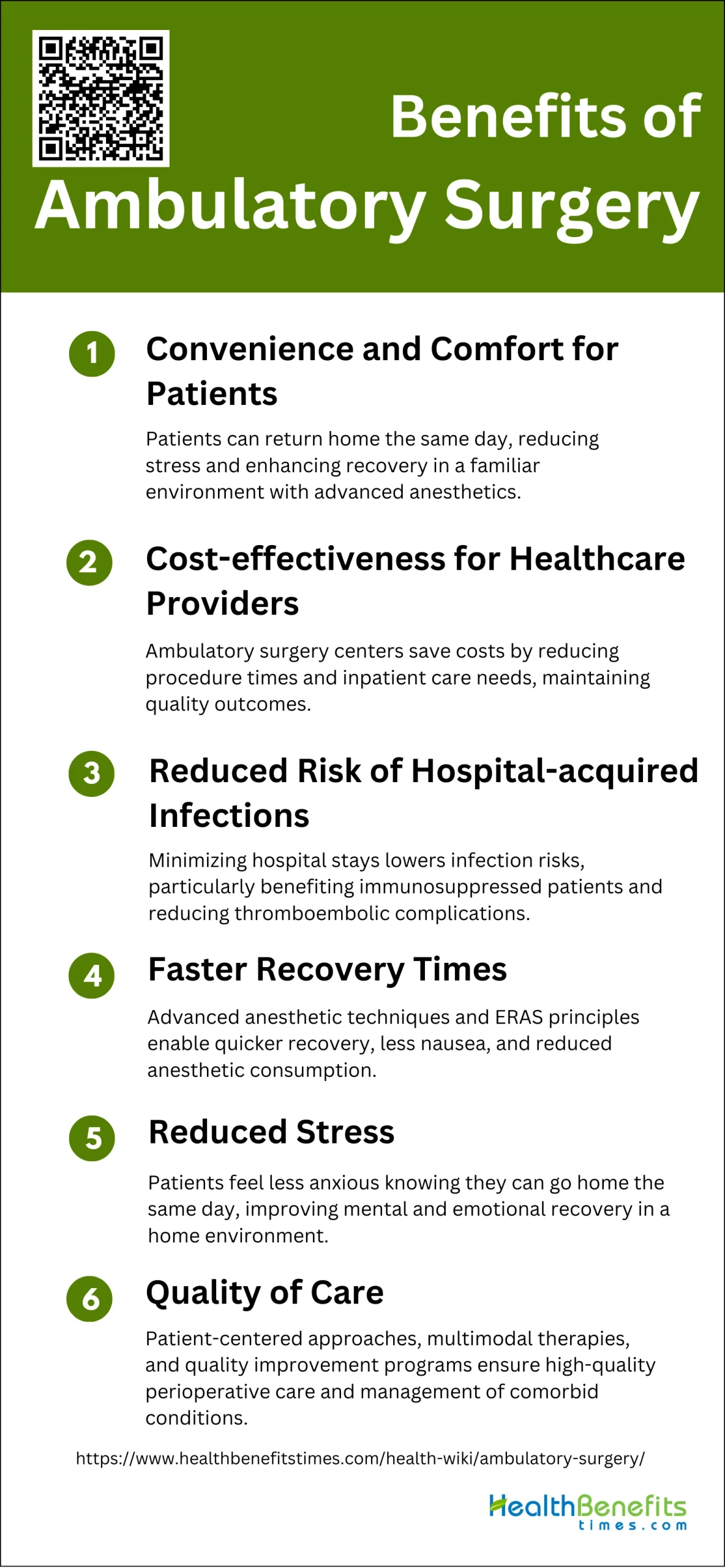 Ambulatory surgery, also known as outpatient surgery, same-day surgery, or day surgery, refers to surgical procedures that allow patients to return home on the same day of the operation without requiring an overnight hospital stay. These procedures are typically performed in specialized facilities called ambulatory surgery centers (ASCs) or in hospital-based outpatient departments. Ambulatory surgeries are designed for patients who are generally healthy or have stable chronic conditions, and they encompass a wide range of procedures across various medical specialties. Common examples include cataract surgery, arthroscopic joint repairs, and minor soft tissue procedures. The key advantages of ambulatory surgery include increased convenience for patients, reduced healthcare costs, and a lower risk of hospital-acquired infections. As medical technology and surgical techniques continue to advance, an increasing number of procedures are being performed in the ambulatory setting, making it an important and growing segment of modern healthcare delivery.
Ambulatory surgery, also known as outpatient surgery, same-day surgery, or day surgery, refers to surgical procedures that allow patients to return home on the same day of the operation without requiring an overnight hospital stay. These procedures are typically performed in specialized facilities called ambulatory surgery centers (ASCs) or in hospital-based outpatient departments. Ambulatory surgeries are designed for patients who are generally healthy or have stable chronic conditions, and they encompass a wide range of procedures across various medical specialties. Common examples include cataract surgery, arthroscopic joint repairs, and minor soft tissue procedures. The key advantages of ambulatory surgery include increased convenience for patients, reduced healthcare costs, and a lower risk of hospital-acquired infections. As medical technology and surgical techniques continue to advance, an increasing number of procedures are being performed in the ambulatory setting, making it an important and growing segment of modern healthcare delivery.
Types of ambulatory surgery
Ambulatory surgery encompasses a variety of procedures that allow patients to return home the same day. These surgeries are typically less invasive and require shorter recovery times compared to inpatient surgeries. Below are some common types of ambulatory surgery:
- Small joint, tendon and muscle repair
- Cataract Surgery
- Lumpectomy
- Carpel Tunnel Surgery
- Meniscus Repair
- Different Nose and mouth procedures
- Tonsillectomy
- Hernia repair
- Laparoscopic gallbladder removal
- Some kinds of cosmetic surgery
- Mole removal
- Arthroscopy
- Dental Surgery
- Tubal Ligation
Benefits of Ambulatory Surgery
Ambulatory surgery offers numerous advantages for patients and healthcare systems alike. This approach allows patients to undergo surgical procedures without the need for an overnight hospital stay, leading to faster recovery times and reduced medical costs. Here are some key benefits of ambulatory surgery:
1. Convenience and Comfort for Patients
Ambulatory surgery offers significant convenience and comfort for patients by allowing them to return home on the same day of their procedure. This minimizes the disruption to their daily lives and reduces the stress associated with hospital stays. Patients benefit from being in a familiar environment, which can enhance their overall recovery experience. Additionally, the use of rapid, short-acting anesthetic and analgesic drugs has improved the perioperative care of outpatients, enabling more invasive procedures to be performed safely on an ambulatory basis. This approach also facilitates early mobilization and higher patient satisfaction, particularly among older adults.
2. Cost-effectiveness for Healthcare Providers
Ambulatory surgery centers (ASCs) provide a cost-effective alternative to traditional hospital settings. Procedures performed in ASCs take significantly less time—on average, 31.8 fewer minutes—than those performed in hospitals, which translates to lower operational costs and the ability to meet higher demand. The economic benefits are further emphasized by the reduced need for inpatient care, which lowers overall healthcare expenditures. Studies have shown that ambulatory-based procedures, such as those for bladder outlet obstruction, offer significant cost savings while maintaining comparable 30-day outcomes relative to inpatient surgeries.
3. Reduced Risk of Hospital-acquired Infections
One of the major benefits of ambulatory surgery is the reduced risk of hospital-acquired infections. By minimizing the time patients spend in a hospital environment, the likelihood of contracting infections is significantly lowered. This is particularly beneficial for immunosuppressed patients who are at higher risk of postoperative infectious complications. The ambulatory setting also has a low incidence of other complications such as thromboembolic events, making it a safer option for many patients.
4. Faster Recovery Times
Ambulatory surgery is associated with faster recovery times due to the use of advanced anesthetic techniques and rapid-acting drugs. For instance, the use of Bispectral Index (BIS) monitoring during anesthesia has been shown to reduce anesthetic consumption and the incidence of nausea and vomiting, leading to quicker recovery room times. Additionally, the implementation of enhanced recovery after surgery (ERAS) principles in ambulatory settings has been shown to improve patient-reported outcomes and facilitate faster recovery.
5. Reduced Stress
The stress associated with surgical procedures is significantly reduced in an ambulatory setting. Patients experience less anxiety knowing they can return home the same day, which contributes to a more positive overall experience. The familiar home environment aids in mental and emotional recovery, reducing the psychological burden of surgery. Moreover, patient-centered care approaches, including shared decision-making and patient education, further enhance the patient experience and satisfaction.
6. Quality of Care
Ambulatory surgery does not compromise the quality of care. In fact, it often enhances it by focusing on patient-centered approaches and continuous quality improvement programs. The use of multimodal analgesic and antiemetic therapy, along with newer anesthetic drugs, ensures optimal perioperative care and treatment. Additionally, the ambulatory setting allows for better management of comorbid conditions such as postoperative nausea and vomiting, obstructive sleep apnea, and diabetes mellitus, ensuring that patients receive comprehensive and high-quality care.
Potential Risks and Considerations
While there are many benefits to various medical and procedural approaches, it is essential to be aware of the potential risks and considerations involved. Understanding these risks can help in making informed decisions and preparing for any possible complications. Here are some key potential risks and considerations:
1. Medical Complications
Medical complications are a significant concern in surgical procedures. For instance, patients with inflammatory arthritis undergoing total hip arthroplasty (THA) have a higher risk of transfusion, mechanical complications, infection, and readmission within 90 days post-surgery. Similarly, chronic preoperative opioid use in patients undergoing cervical fusion increases the risk of wound complications, emergency department visits, and long-term opioid use post-surgery. Additionally, cardiovascular complications are notably higher in patients undergoing gastrointestinal endoscopy, especially those with pre-existing cardiac conditions. Identifying and managing these risk factors preoperatively can help mitigate these complications.
2. Patient Selection
Proper patient selection is crucial to minimize postoperative complications. Factors such as age, comorbidities, and preoperative conditions significantly influence outcomes. For example, older age, obesity, smoking, and diabetes are independent predictors of wound complications in patients undergoing extremity soft tissue sarcoma resection. Similarly, patients with a history of cardiac disease, preoperative neurologic abnormalities, and corticosteroid use are at higher risk for complications following spine surgery. Therefore, thorough preoperative assessments and tailored surgical plans are essential for optimizing patient outcomes.
3. Postoperative Care
Effective postoperative care is vital for reducing complications and ensuring patient recovery. For instance, patients with inflammatory arthritis require optimized health and medication management before and after THA to minimize complications. In pediatric patients, identifying preoperative risk factors such as airway comorbidities and developing a management plan for respiratory complications in the postanesthesia care unit (PACU) is crucial. Additionally, patients undergoing deep brain stimulation surgery benefit from supervised learning algorithms that predict adverse outcomes, allowing for tailored postoperative care. Comprehensive postoperative care plans can significantly improve patient outcomes and reduce readmission rates.
4. Access to Emergency Care
Access to emergency care is a critical consideration for patients undergoing surgery, especially those with higher risk profiles. For example, patients with chronic preoperative opioid use undergoing cervical fusion have increased emergency department visits and readmissions within 90 days post-surgery. Similarly, patients with inflammatory arthritis undergoing THA have higher readmission rates due to complications. Ensuring that these patients have timely access to emergency care can help manage complications effectively and reduce the risk of severe outcomes.
5. Support at Home
Adequate support at home is essential for patient recovery post-surgery. For instance, patients undergoing abdominoplasty with combined procedures have higher complication rates, necessitating robust home support systems for effective recovery. Additionally, patients with chronic conditions such as diabetes or those on long-term opioid therapy require careful monitoring and support at home to manage postoperative complications. Providing patients and their families with the necessary resources and education can enhance recovery and reduce the likelihood of complications.



